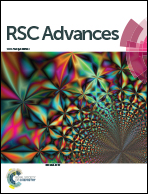Degradation of aniline with zero-valent iron as an activator of persulfate in aqueous solution†
Abstract
Zero valent iron (ZVI) can activate persulfate to generate sulfate free radicals which are a strong oxidant to degrade organic pollutants. The oxidative degradation of aniline in aqueous solution by persulfate activated with zero valent iron was studied under laboratory conditions. Batch experiments were conducted to investigate the effects of different parameters such as pH, ZVI concentration, aniline concentration, persulfate concentration and reaction temperature on aniline degradation. The results showed that aniline degradation increased with increasing temperature. The optimum dosage of ZVI was 0.4 g L−1 and 85% aniline degradation was observed. Maximum aniline degradation was observed at pH 4.0, whereas at pH above or below 4.0, aniline degradation efficiency was decreased. In the persulfate-ZVI system, the apparent energy of activation for aniline degradation was 14.85 kJ mol−1. The existence of persulfate radicals and hydroxyl radicals produced during the degradation of aniline were identified with scavenger ethanol and tert-butyl alcohol. The reaction intermediates nitrobenzene, nitroso-benzene and p-benzoquinone were detected by gas chromatography-mass spectrometry and based on these intermediates obtained a probable pathway for aniline degradation has been proposed.


 Please wait while we load your content...
Please wait while we load your content...